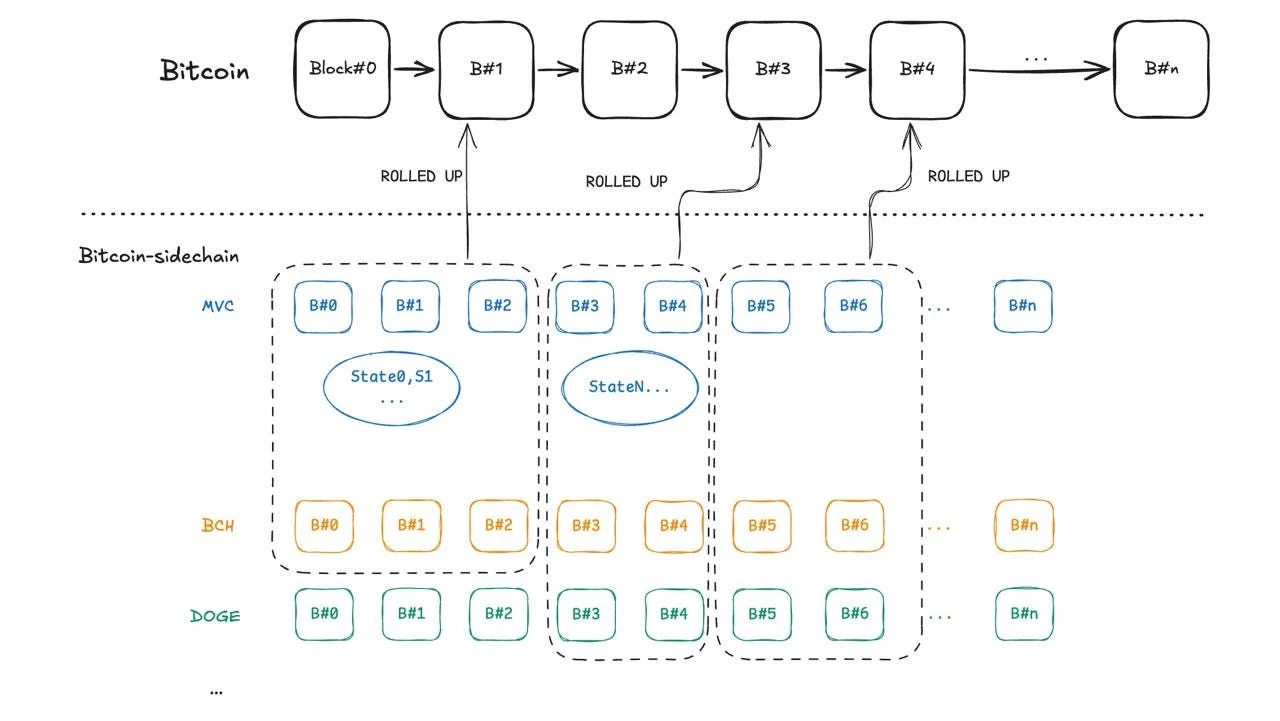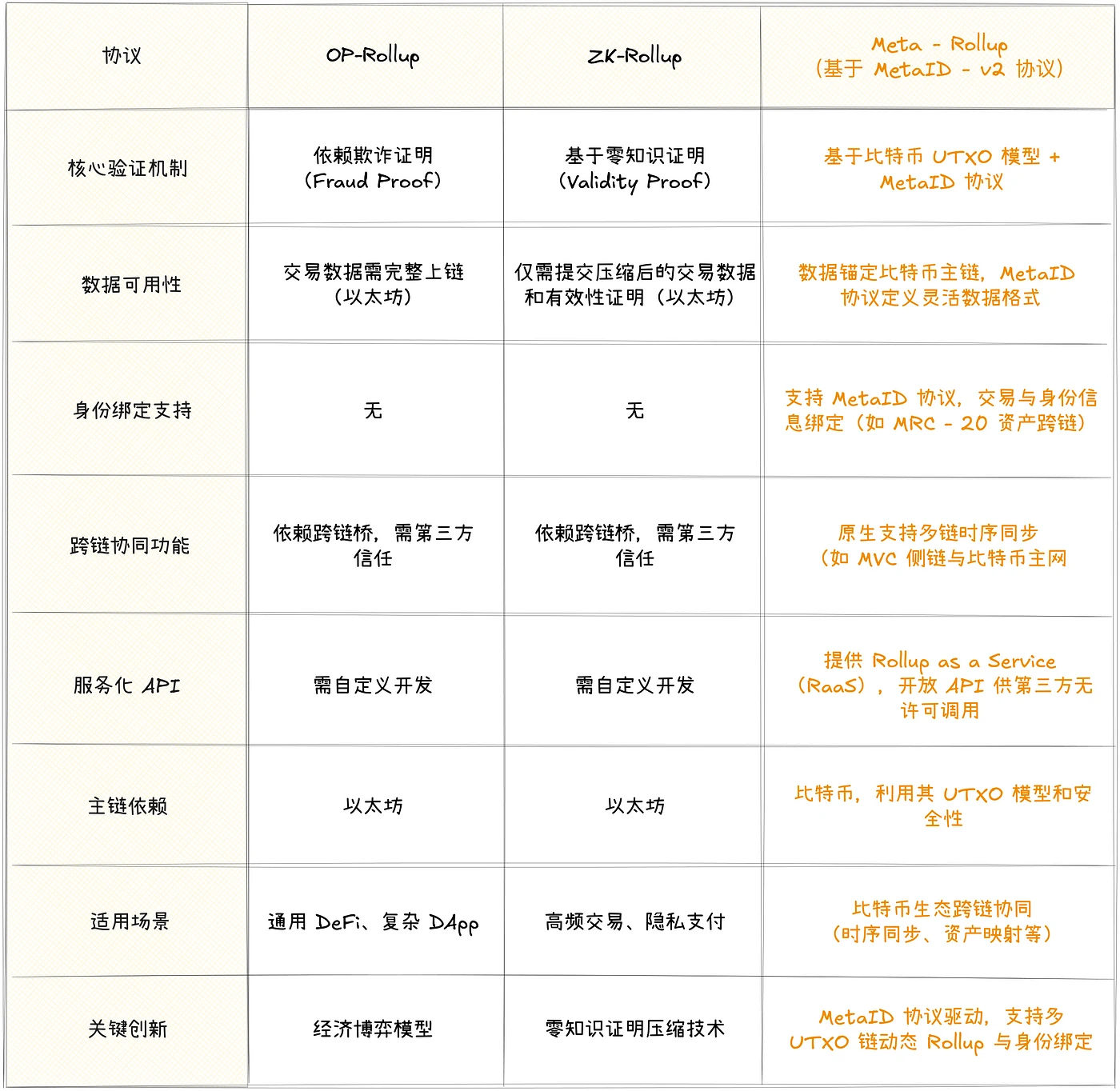
Meta-Rollup has been officially launched. As part of the MetaBitcoin Network plan, it provides a new interaction mechanism and expansion capabilities between the Bitcoin mainnet and the sidechain. The design of Meta-Rollup not only solves the timing problem between Bitcoin and its sidechain, but also realizes the unified data structure between multiple chains and the infrastructure of cross-chain applications. The following is a technical introduction to Meta-Rollup to help developers and technology enthusiasts better understand this innovation.
What is Meta-Rollup
Meta-Rollup is an efficient and scalable Rollup solution designed and implemented under the framework of the MetaBitcoin Network project. Its core innovation is to package the key information of the Bitcoin sidechain and other UTXO public chains (LTC, Doge, BCH...), including transaction data and block information, in a standardized format and upload it to the Bitcoin mainnet, thereby building a tight integration and timing synchronization mechanism between the Bitcoin mainnet and the sidechain. Specifically, Meta-Rollup maps the sidechain transaction data to the Bitcoin mainnet through Merkle hash technology, allowing the mainnet to effectively verify transactions on the sidechain without compromising the security, decentralization and anti-censorship capabilities of the Bitcoin mainnet. This mechanism not only improves the efficiency of cross-chain data transmission, but also ensures the interoperability and consistency between the mainnet and the sidechain, thereby optimizing the scalability and performance of the entire network.

Technical Challenges of Implementing Meta-Rollup
In terms of technical implementation, one of the main challenges facing Meta-Rollup is the lack of previous references. The concept of Rollup is no longer new in the Ethereum network, but there are fundamental differences between the Bitcoin network and the Ethereum network. Bitcoin uses the UTXO (unspent transaction output) model, while Ethereum uses the account model, which greatly increases the complexity of cross-chain transactions and data verification. In Ethereum, Rollup can efficiently handle a large number of state updates and transaction verifications through smart contracts and virtual machines, while Bitcoin lacks similar functional support.
Therefore, Meta-Rollup must innovatively use Bitcoins Merkle hash mechanism to map sidechain transaction data to the main chain, while ensuring that the main chain can effectively verify the status and transactions of the sidechain. Another difficulty is the limitation of Bitcoin block size. The capacity of each block in the Bitcoin network is relatively small, which requires Meta-Rollup to optimize data compression and transmission efficiency to ensure that sidechain data can be effectively stored in a limited block space and will not impose an excessive burden on the performance of the main network. In addition, since the Bitcoin main network does not directly support high-frequency status updates and complex interaction logic, how to achieve fast and reliable Rollup operations without sacrificing Bitcoins security and decentralization has become a key challenge in technology development.
Timing synchronization is another key technical difficulty faced by Meta-Rollup in the Bitcoin network. Since the block time of the Bitcoin mainnet is about one block every 10 minutes, and the transaction processing speed on the sidechain is usually faster, how to ensure the consistency of data timing between the Bitcoin mainnet and the sidechain has become a major challenge. Transactions on the sidechain must be mapped to the mainnet in a timely and accurate manner so that the mainnet can verify and confirm these transactions. If the timing is not synchronized, it may cause delays in transaction verification and even data inconsistencies, affecting the reliability of the system. These challenges have been overcome by the team, thus truly realizing Meta-Rollup.

Why choose Meta-Rollup?
Bitcoin’s expanding ecosystem faces a growing challenge: separate sidechains and UTXO chains operate like “parallel universes” that do not intersect with each other and lack a unified clock to order cross-chain interactions. This fragmentation poses risks to atomic swaps, asset bridging, and smart contract interoperability.
Meta-Rollup solves this problem by establishing a shared time frame:
Block sequence alignment: Sidechain blocks are regularly hashed and committed to Bitcoin mainnet blocks, creating a verifiable timeline.
Merkle-ized cross-chain proofs: Cross-chain transactions are aggregated into a Merkle tree, with the root node stored in Bitcoin. This allows lightweight cross-chain event order verification.
Decentralized Trust Anchoring: By inheriting Bitcoin’s consensus security, the sidechain obtains tamper-proof timestamps without relying on centralized oracles.
This architecture lays the foundation for the vision of the MetaBitcoin Network — a dynamically scalable network of UTXO chains in which Bitcoin serves as the supporting skeleton for time and cryptography.
Technical Innovation of Meta-Rollup
Although the Rollup mechanism is mature in the Ethereum ecosystem, Meta-Rollup has pioneered innovations centered on Bitcoin:
1. Multi-UTXO chain aggregation
Supports concurrent Rollup operations on multiple UTXO-based public chains (LTC, Doge, BCH, FB...). Through a novel UTXO merging algorithm, transactions from different chains are batched into a single Bitcoin transaction, reducing the on-chain footprint while maintaining atomicity.
2. Dynamic block interval configuration
The rollup interval is programmable as a divisor of 144 blocks (≈ 1 Bitcoin day). Chains can choose intervals (such as 24, 48 blocks) to balance cost and synchronization granularity. The penalty mechanism ensures that validators do not miss the deadline.
3. Rollup as a Service (RaaS)
Third parties can access Rollup proofs without permission through a unified API ( https://api.metabitcoin.network/api ), including:
Block headers sorted by time
Cross-chain Merkle inclusion proof
Bind MetaID identity authentication
4. MetaID Integration Data Schema
Rollup data payload follows the MetaID protocol, which is a flexible data container that supports:
Identity binding: Associating Rollup data with a decentralized identifier (DID).
Schema polymorphism: Encode heterogeneous data types (e.g., asset mapping, smart contract logs) into a standard format.
Application scenarios and ecological impact
Cross-chain time sorting
Applications that require strict cross-chain transaction ordering (such as decentralized exchanges, options contracts) can now resolve time disputes by referencing Bitcoin’s authoritative timeline.
Multi-chain asset mapping
Meta-Rollup records the lock/unlock events of cross-chain assets and supports trust-minimized bridging. For example, a wrapped BTC issuer on a sidechain can prove asset collateral through a Merkle proof anchored on Bitcoin.
Smart Contract State Finality
By submitting the hash of the sidechain smart contract execution results to Bitcoin, Meta-Rollup enables future Bitcoin layer-2 networks to verify historical states without re-execution.
Paradigm Shift: From Chaos to Unity
Before Meta-Rollup, Bitcoin’s sidechains existed in a “grey zone” of time — operationally viable, but cryptographically disconnected. Meta-Rollup eliminates these boundaries, creating a unified cross-chain spacetime where:
Each sidechain block has a provable position in the Bitcoin timeline.
Cross-chain transactions inherit the immutability of Bitcoin.
Developers can build cross-chain dApps based on a deterministic order of events.
This is not only a technological upgrade, but also a redefinition of the role of Bitcoin - from an independent ledger to the time root of a multi-chain universe.
Summarize
The emergence of MetaBitcoin Network and Meta-Rollup has brought unprecedented cross-chain capabilities to Bitcoin, and promoted the development of multi-chain collaboration and decentralized finance in the Bitcoin ecosystem. Through innovative technologies such as timing synchronization, asset mapping, and cross-chain smart contract execution, the technical bottleneck between Bitcoin and side chains has been solved, allowing the Bitcoin network to support more complex application scenarios while maintaining decentralization. With the help of Meta-Rollup, Bitcoin is no longer an isolated digital asset, but has become the core hub of global decentralized finance and multi-chain ecology, moving towards a more open and interoperable future. This not only allows Bitcoin to transform from digital gold to programmable network, but also gives many Bitcoin side chains and UTXO networks stronger vitality.










